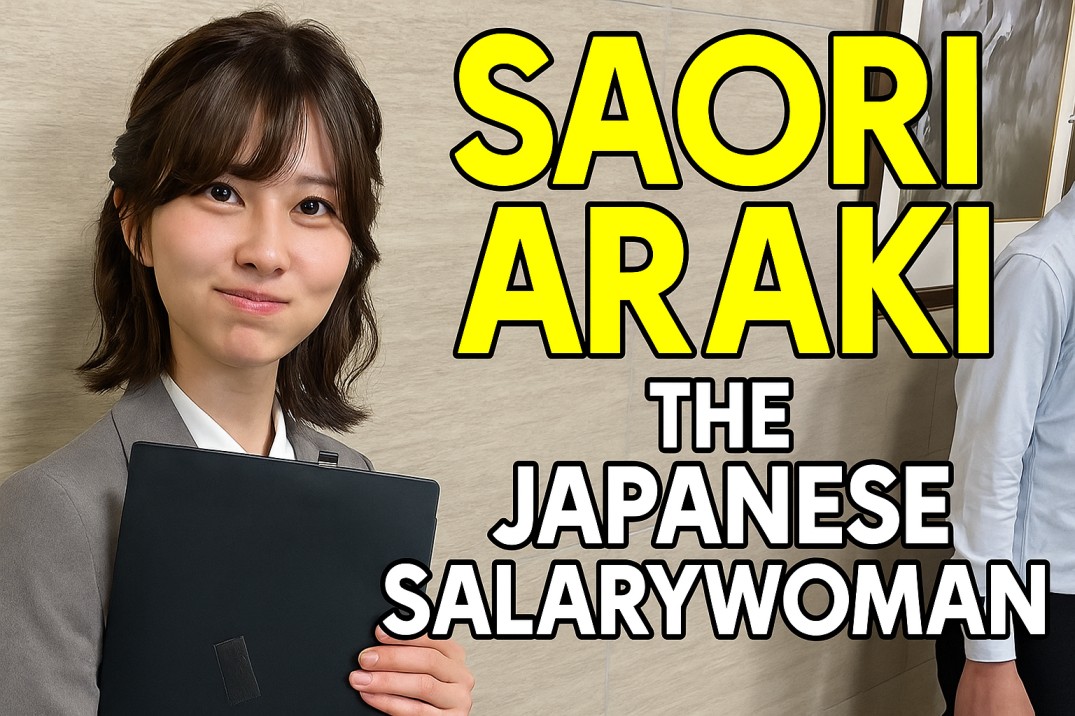
SAORI ARAKI THE JAPANESE SALARYWOMAN
In late July 2025, a single photo changed everything for Japanese model Saori Araki. The former J-pop idol from Tokyo Girls Bravo posted a simple selfie from a corporate event. She wore a plain grey office suit, held a laptop folder, and smiled with slightly puffed cheeks. Her tweet caption read “おはよう☀️ (Good morning)” – posted around 10 PM local time. This late-night “Good morning” made people laugh at the irony. Within four days, the image collected over 70 million views and sparked a global meme explosion. Internet users nicknamed her the “Japanese Salarywoman” and praised how her professional smile and grey suit captured that classic corporate worker energy. An ordinary office selfie became one of the internet’s biggest meme templates overnight and sparked a mix of semi-ironic thirst and genuine admiration.
Who is Saori Araki?

Saori Araki (荒木佐保里) is a Japanese model and actress originally from Nagasaki. She gained public recognition as a former member of the J‑pop idol group Tokyo Girls Bravo, which debuted in early 2024. Araki officially left the group in February 2025
Origin Story: How Saori Araki’s 10 PM ‘Good Morning’ Tweet Broke the Internet
Araki’s viral moment started with her own social media post. On July 24, 2025, she tweeted the photo from a Takeda corporate event visit. Takeda is a well-known Japanese pharmaceutical company. She stood straight in her grey suit and white shirt, holding a black folder and smiling with puffed cheeks – she looked exactly like a 勤め人 (office worker). The tweet simply said “Good morning ☀️.”
おはよう🏢 pic.twitter.com/dwACkrsYUz
— 佐保里(SAO) (@kawausosuki0513) October 18, 2024
People couldn’t stop talking about how stunning Araki looked. The internet exploded with what we call “thirstposting” – basically, people openly admiring someone’s appearance online. Users kept commenting on Araki’s “visual queen” energy, even though she wore just a simple grey suit.
Here’s what made this so fascinating: Araki somehow transformed ordinary office clothes into something that looked like haute couture. Fashion observers couldn’t believe how a standard business outfit could look so elevated on her. Fans praised her “effortless charisma” and natural beauty, turning the photo into an unexpected officewear fashion statement.
The response split into two camps. Some people genuinely admired her style and presence, while others posted more playful, attraction-based comments. KnowYourMeme captured this perfectly, describing the reaction as “semi-ironic thirst and earnest adoration” – meaning people mixed genuine appreciation with internet-style flirting.
This combination created the perfect viral storm. When someone makes basic professional wear look extraordinary, and when that person has undeniable screen presence, the internet takes notice. Araki didn’t try to create a fashion moment, but her natural confidence and style made even the most boring office uniform look like a runway piece.
The meme worked because it showed how personal charisma can transform anything – even a plain grey suit – into something people can’t stop discussing online.
Araki’s appearance matched a familiar cultural concept. In Japan, a salaryman represents a white-collar office employee in a plain dark suit, and salarywoman is the female version. The term salaryman is portrayed as a white-collar worker who shows unwavering loyalty and commitment to his employer, prioritizing work over anything else, including family. With her neat bob haircut and grey suit, Araki literally embodied the stereotype of a Japanese corporate employee. Recent data shows that about 70 percent of women in Japan now work, up several percentage points since 2000. However, the gender wage gap remains significant, with women earning approximately 75.7% of what men earn. Viewers worldwide immediately recognized her as an office worker. Many commenters called her “taishoku” (退職) or “elegant,” saying she looked like someone who just stepped off a Tokyo commuter train into a meeting. Even though she wasn’t internationally famous before, her polished appearance and warm smile made the photo feel both familiar and special. Overnight, people started sharing her name and image everywhere. Multiple sources began documenting the phenomenon as it unfolded. Araki gained thousands of new followers as curious fans flocked to see the “salarywoman” behind the meme.
Viral Explosion: From Office Selfie to Worldwide Meme Template in 72 Hours

Araki’s photo exploded across social media platforms. By July 25, just one day after posting, replies and quote-tweets flooded in. One user wrote “Just wrapped my car around a telephone pole,” joking that Araki’s look was so striking he nearly crashed. This post quickly earned 50,000+ likes in one day. A popular meme page reposted that joke and added 10,000 more likes within days. Social media algorithms detected all these reactions and pushed the image to even more users. On July 26, accounts began creating remixes of Araki’s photo. User @Andr3jH Photoshopped the image so she appeared to hold a very heavy academic book, with a caption about suddenly studying a PhD dissertation. That video-style post collected 218,000 views and 7,100 likes, showing how creatively people used the image.
The next day, July 27, the meme spread internationally. X/Twitter user @eigenrobot created a side-by-side image of Araki and Western actress Sydney Sweeney under the tagline “Which Way Western Man.” This referenced a popular meme format where people choose between Eastern versus Western “dream girls.” That poll post accumulated tens of thousands of votes and likes, sparking debates about style and beauty standards. Meanwhile, Araki joined the fun by tweeting a second photo in the same grey suit – this time flashing a cute peace sign. Fans seized the moment immediately. One person posted the famous “George W. Bush learning about 9/11” meme image and wrote “A second photo has hit the timeline.” This joke, showing Bush’s shocked expression, went viral too. Within days, people had quoted and remixed the original tweet thousands of times on X/Twitter, with Araki’s name trending worldwide. The photo appeared on Instagram meme pages and TikTok, where users set it to music or created slideshow formats. One TikTok video featuring the image earned 18,000+ likes. By the weekend of July 26–27, Araki’s simple “Good morning” selfie had snowballed into a global internet sensation – not because of any news event, but purely from creative fan reactions.
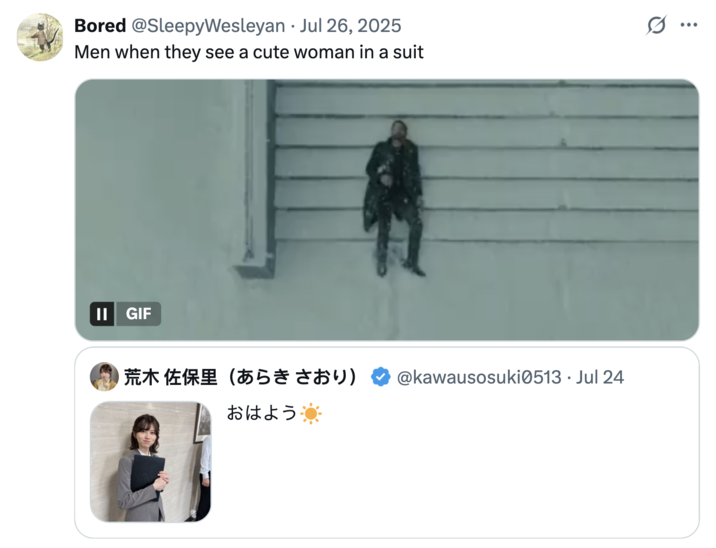
Why Everyone Lost Their Minds Over Saori Araki’s Grey Suit
Fans joked that seeing her in a suit was both professional and unexpectedly attractive. One popular reaction caption read “Men when they see a cute woman in a suit” (paired with a Ryan Gosling GIF from Blade Runner), which became shorthand for “immediate crush” – it went viral as soon as people shared it. Others pointed out how she represented an ideal that Western internet users found appealing. The contrast of a plain office outfit looking beautiful led to lines like “She makes a grey suit look like haute couture.” These playful compliments mixed genuine praise with humor.

What Actually Happened: Her photo exploded across social media platforms worldwide. Users shared it thousands of times within hours. The image triggered massive waves of what internet culture calls semi-ironic thirstposting — when people post admiring comments that walk the thin line between joking around and genuine attraction.
The Viral Explosion: Meme pages grabbed the photo first. Anime fan accounts followed quickly. Fashion enthusiasts jumped in next. Regular social media users then shared it everywhere with increasingly creative captions.
The comments people wrote became legendary:
“This woman could make me pay taxes willingly.”
“She’s my Roman Empire.”
“I just crashed my car looking at her.”
Internet culture thrives on exaggeration, and people ran wild with the image. One extreme meme tweet read “I am sorry for what the Americans did at Pearl Harbor.” This dark historical reference was used tongue-in-cheek – the joke was apologizing for how stunned Americans (and others) were by Araki’s photo. It actually earned over 100,000 likes. Another person mocked fringe views with the meme “White Supremacist when they realize they have to f— white women to preserve their race,” highlighting how a beautiful non-white woman shattered stereotypes. These jokes might sound edgy, but they reflect the meme’s playful self-awareness. Studies show that viral phenomena spread when objects or patterns can replicate themselves or convert other objects into copies. Online communities love mixing pop culture with current viral moments, and Araki’s photo gave them a perfect canvas. It fit into existing meme formulas – boss versus girlfriend comparisons, reaction GIFs, polling quizzes – so it traveled easily across platforms.

The emotional resonance was powerful. Workers related to the “post-vacation” mood of the caption, while others simply enjoyed the unexpected attraction angle. Japanese office workers typically work basic hours from 9 am to 5 pm or 6 pm, but many stay until 9-10 pm, creating that familiar “back-to-work blues” feeling. Japanese media noted that many employees dread Monday mornings or returning from holidays. Araki’s late-night “Good morning” poked fun at that shared feeling. The psychology behind viral trends shows that people participate because they see others doing it – a form of social proof. Social media comments praised her “visual queen” appearance and pointed out how she transformed an everyday suit into something elegant. This combination of genuine admiration (she is very photogenic) and ironic humor (the over-the-top jokes) kept people engaged. The meme worked because it turned a normal office scenario into something funny and charming, blending nostalgia for daily routines with internet comedy’s absurdity.
Remixes and Spin-Offs: The Memes That Followed
Creative remixes of the image appeared almost immediately. Early versions used simple caption variants: people took “Men Only Want One Thing” templates and replaced the punchline with Araki’s picture for office-related twists. Others literally drew “attraction beams” or hearts onto the image. The two photos of Araki got turned into comic panels or side-by-side comparisons, similar to other multi-picture meme formats. Social tools like Kapwing and meme-maker apps flooded with Araki’s suit picture, with users overlaying text about work, dating, or comparing her to anime office ladies.

Distinct meme formats quickly developed. Besides the “Which Way Western Man” poll, one spin-off superimposed Araki’s face onto John Travolta’s body in the Guardians of the Galaxy dance GIF. Others made reaction GIF compilations, sometimes merging Araki’s photo into reaction videos. On TikTok, video creators set the photo to catchy songs or turned it into short slideshow jokes, though static images dominated. The key was blending Araki’s image with well-established meme structures.
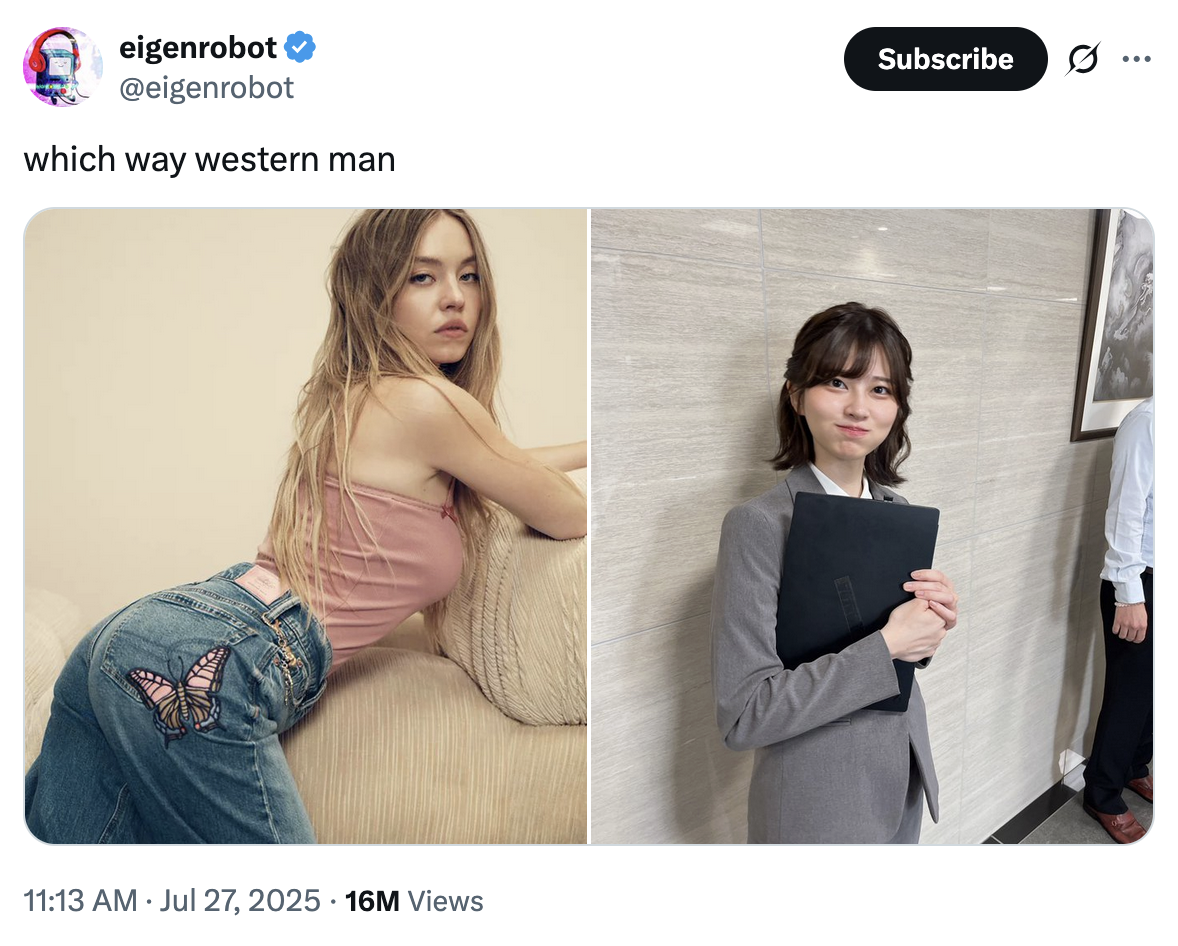
The second photo sparked its own trend. After Araki posted the peace-sign selfie, meme-makers jumped on that moment. Besides the Bush “timeline” joke, people created countdown or alarm-clock jokes implying “brace yourselves, she’s posting another photo!” The “meme arrow” image macro also appeared, labeling Araki’s suit photo as a new trend to watch. KnowYourMeme’s gallery later listed at least 18 distinct meme images using Araki, showing the range from straightforward attraction posts to ironic historical references. Each new variation kept the meme alive on users’ feeds, so even after the original tweet faded, the jokes kept circulating.
Cultural Impact and Discussion: When Memes Meet Reality
Most impact stayed online, but it sparked broader conversations. For several days, international media mentioned the phenomenon. Social media saw crossovers where anime and gaming fans compared fictional office-lady characters to Araki’s pose. The Sydney Sweeney meme buzz often appeared alongside mentions of Araki, fueling discussions about Eastern versus Western beauty standards on Twitter. Some brands caught onto the term “salarywoman” and made light posts with #salarywoman, though none officially used Araki’s image.
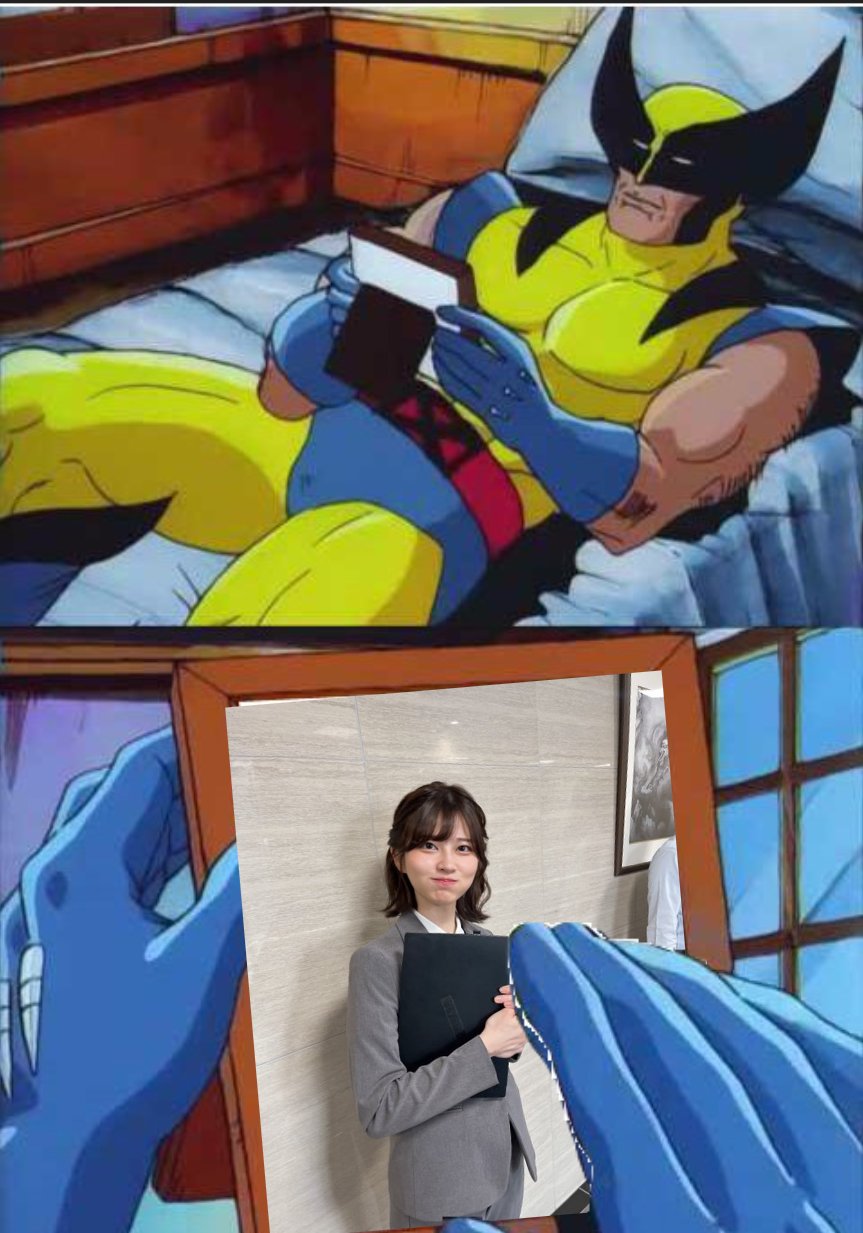
No controversy emerged. Although some people worried the meme played into fetishizing Asian women in corporate uniforms or making racially charged jokes. A few threads debated whether memes like the Pearl Harbor joke crossed lines of good taste. However, these concerns remained small. No company or government requested it stop. The overall reaction was laughter and admiration rather than backlash. Araki herself seemed comfortable with the attention, continuing her normal posts. She’s known as a polite, professional personality in Japanese media. A few users humorously made “meta-memes” that gently mocked the internet’s habit of turning every ordinary photo into a viral joke. The meme became part of internet folklore – demonstrating how even a quiet office snapshot can explode into a global phenomenon.
Current Status & Global Spread : Where the Meme Stands Today
By late July 2025, within one week, the “Japanese Salarywoman” meme had mostly run its course, but it still trended on Twitter/X briefly. Araki’s original tweet reached 40+ million views by then, and her follow-up suit photos on Instagram and X continued collecting likes. The hashtag and her name trended on X, and meme pages kept reposting the image. On Instagram, she posted a slideshow of more suit photos that earned thousands of likes. By early August, new mentions decreased significantly – the meme had peaked. It never gained traction on controlled platforms like Facebook and remained absent from professional sites like LinkedIn beyond quick explainers.
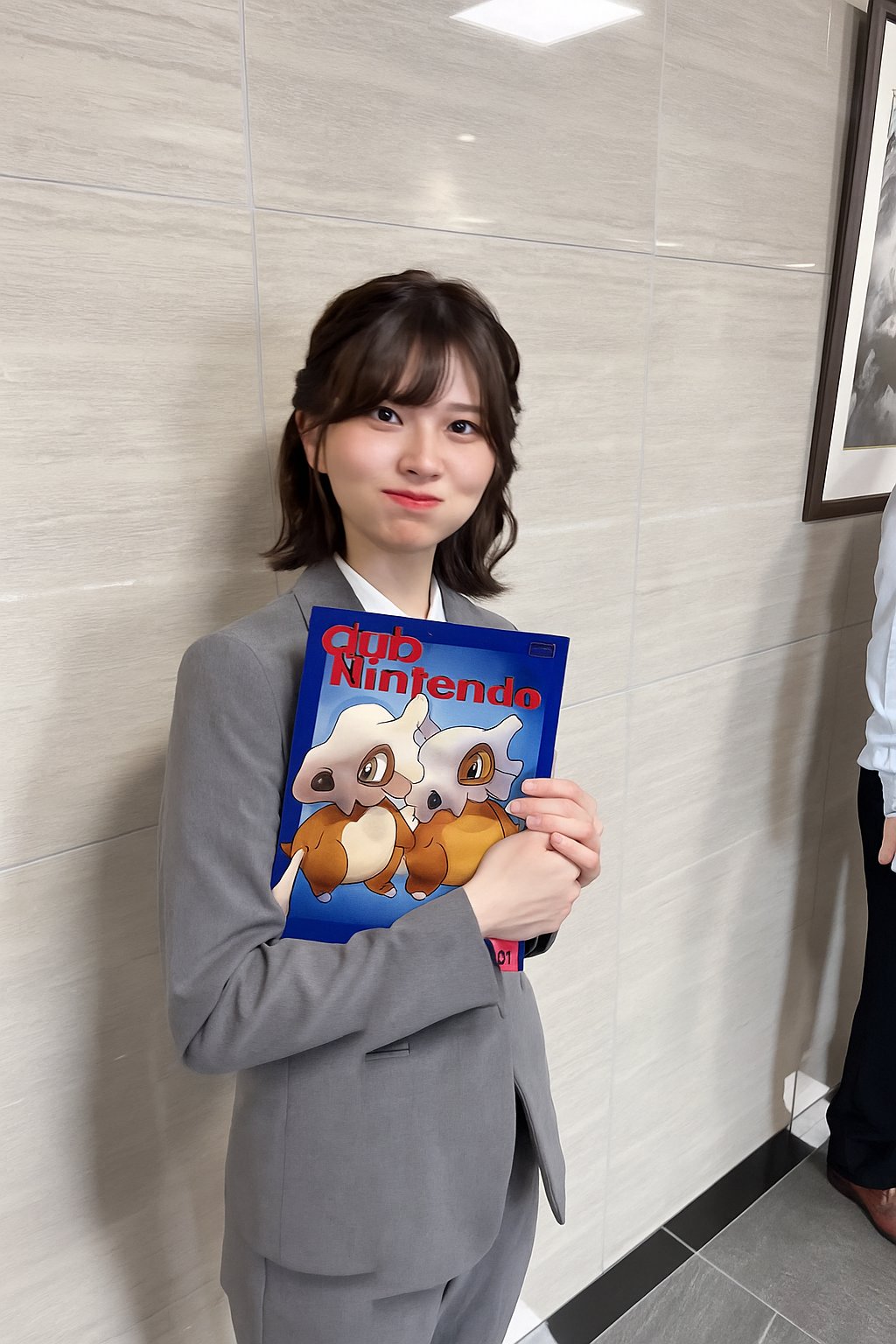
Geographically, the meme started in Japan but quickly spread to English-speaking countries including the US and UK. Sites in Southeast Asia like Indonesian AboutMalang and Chinese and Korean social feeds picked it up. A Taiwanese TikToker made a short viral video about Araki. It resonated wherever young, internet-savvy people gathered. Gen Z and younger millennials on Twitter and TikTok embraced it most, along with meme forums like Reddit where it gained buzz in meme subreddits. Searches for “Saori Araki” and related terms spiked worldwide during that week. Now, the meme lives mostly in archives. KnowYourMeme catalogued all the images and threads, and meme enthusiasts might discover it as a quirky example from 2025.
A few late spin-offs appeared. Some users reposted the photo months later with tags like #salarywoman as nostalgic throwbacks. Other office-themed images briefly trended by being compared to Araki – someone wore a suit and knowing smile as a reference. But no official “Salarywoman 2.0” emerged. Araki has continued her modeling and acting career normally. If she posts another similar photo, fans might call it a “Salarywoman revival,” but currently the image serves more as meme-history documentation than an evergreen template. It will probably appear in roundups of 2025’s viral moments or collections of office-themed memes.
Key Players
Saori Araki started the meme – she remains active on social media (@kawausosuki0513 on X and Instagram) and posted the original image. Before this event, Araki was mainly known in Japan as a model and actress. Her Tokyo Girls Bravo idol background gave her some followers. This incident made her an accidental global name. Fans describe her as calm and professional, which made the sudden meme fame surprising.
Many social users powered the meme’s spread. Early amplification came from accounts like @badchestpain and @moist654 (who joked about the car accident), @Andr3jH (the heavy book edit), and @eigenrobot (the Sydney Sweeney poll). Others include @kpoping6 (who did the Bush/9-11 joke) and @SleepyWesleyan (who made the Ryan Gosling GIF reaction). These people aren’t celebrities, but they had enough followers to make each meme variation spread. Instagram meme curators like @moist654 on Instagram also reposted content for extra reach.
Online communities amplified the trend. Multiple documentation sites quickly covered the story, giving it official recognition in meme circles. Reddit meme forums and Instagram meme pages picked it up, so people on different platforms discovered Araki’s image. Even after the viral peak, some underground meme-makers kept creating new jokes in late July to extend its life. It was a collective effort: Araki’s photo plus dozens of jokers and meme-enthusiast accounts working together transformed it into a worldwide phenomenon.
Future Outlook
The Japanese Salarywoman meme will probably become a quirky memory rather than a long-term trend. The image connects closely to that specific late July 2025 moment. Without a new twist from Araki or a major related event, it will likely fade. We might see occasional throwback posts – someone might tweet “Remember this?” with the photo when discussing 2025’s viral memes. If Araki later posts unusual photos in different outfits, fans might make new jokes and call it a comeback. But currently, the meme’s momentum has passed.
The template could reappear. The concept “attractive professional woman causes internet chaos” might get reused if a similar case happens. If another office-themed photo of someone appealing goes viral, people might say “Oh, another Salarywoman meme revival!” Meme culture often sees old jokes revived when patterns repeat. Maybe in late 2025 or 2026, someone will compare a new photo to Araki’s. As it stands, the “Japanese Salarywoman” meme will likely remain a humorous footnote – remembered mainly by internet culture fans as an example of that summer’s viral flavor.
Key Takeaways
- Timeline: Within days (July 24–27, 2025) Araki’s single tweet went from casual to famous. Early reactions on July 25 (like the “telephone pole” joke) ignited the trend, which peaked by the weekend.
- Platforms & Format: The meme lived mostly on Twitter (X), with shares on Instagram and some videos on TikTok. It used image macros and quote-tweets (photo-plus-caption or reaction GIFs) as the main format.
- Emotional Hook: The image combined everyday office normalcy with absurd admiration. Fans mixed genuine attraction jokes (“visual queen energy”) and dry humor (like apologizing for Pearl Harbor) about a common scenario (post-holiday office blues). This blend of attraction plus irony made it memorable.
- Memes & Remixes: Popular spin-offs included side-by-side polls (“Which Way Western Man” comparing Araki to Sydney Sweeney), reaction GIF captions (the “cute in a suit” Ryan Gosling GIF), and text jokes (the Pearl Harbor apology, the “White Supremacist” line). Each new meme format broadened its appeal.
- Cultural Spread: It became a global meme. Reports and posts appeared in Japan, the US, Indonesia, and beyond. Indonesian and Japanese media wrote explainers, and meme pages worldwide bookmarked Araki’s photo. It struck a chord especially with Gen Z on Twitter, TikTok, and meme forums.







